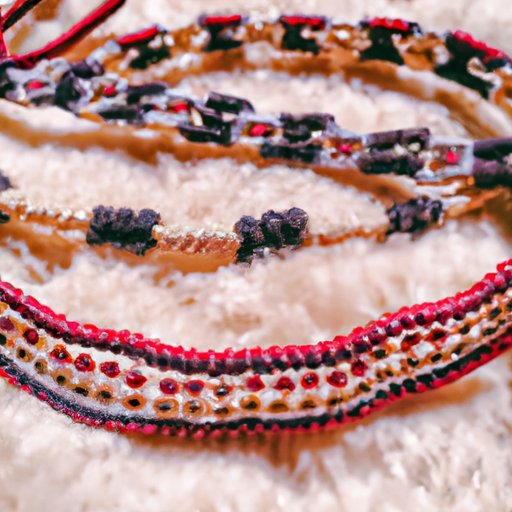Introduction
Waist beads are a type of body jewelry worn around the waist, made of small beads or charms strung together on a thread or string. They have been used as a cultural accessory for centuries and continue to hold significant meaning in various African cultures. The purpose of this article is to explore the origins and cultural significance of waist beads, as well as their modern trend and associated health benefits. This article is aimed at anyone interested in learning more about waist beads, including those who wear them or are curious about their cultural significance.
Historical Perspective
Waist beads have a long and rich history in various cultures throughout Africa. They were originally used as a symbol of femininity, fertility, and sensuality. Women would wear them as a sign of beauty and youthfulness, as well as to celebrate important life events such as puberty, marriage, and childbirth. In some cultures, waist beads were also worn as a form of protection against evil spirits.
Waist beads have been used in many different ways throughout history, depending on the culture and context. In certain African cultures, they were used as a status symbol or a way to display wealth. For example, the Yoruba women in Nigeria would wear waist beads made of expensive materials such as coral or glass beads. In other cultures, waist beads were used as a form of spiritual protection or a way to honor ancestors.
Anthropological Analysis
Waist beads hold tremendous cultural significance in various African cultures. They are often used as a symbol of femininity, fertility, and sensuality. In many cultures, the wearing of waist beads is considered a rite of passage, signaling a girl’s transition to womanhood. They are also believed to have spiritual and healing powers.
Waist beads are very personalized and often have specific meanings for the wearer. For example, the colors of the beads may represent certain characteristics or personality traits. The number of beads may signify a goal or intention the wearer has set for themselves. Additionally, certain beads may be chosen for their healing properties or their association with particular chakras.
Rituals or ceremonies associated with waist beads vary from culture to culture. In some cultures, waist beads are given to a woman by her mother or grandmother as a coming of age gift. In other cultures, waist beads are worn during fertility rituals or as a way to honor ancestors. They may also be worn during important life events such as weddings or childbirth.
Fashion and Trend Study
In recent years, waist beads have become a popular fashion trend in Western cultures. Many people wear them as a form of body adornment or a way to express their individuality. They come in a variety of styles, from simple, single-strand beads to more elaborate designs with charms or tassels.
The trend has evolved from their traditional African roots to include new styles and materials. For example, waist beads may now be made of crystals, metal beads, or even plastic. They are often worn with crop tops, bikinis, or low-rise jeans to show them off as a fashion accessory.
Moreover, wearing waist beads has become a way to reclaim and celebrate African heritage in Western societies. It has become a symbol of empowerment for many African women, helping to connect them with their culture and ancestral traditions.
Health and Wellness Discussion
Beyond their cultural significance and fashion trend, waist beads are also associated with various health benefits. One of the most commonly cited benefits is menstrual cycle tracking. The beads can be strung in a specific pattern or color to help the wearer track their menstrual cycle. It can also be a tool to help women become more aware of their menstrual cycle and to track any irregularities.
Another popular health benefit associated with wearing waist beads is weight management. The beads can be worn to help monitor changes in waist size, acting as a reminder to maintain a healthy diet and exercise regimen. Additionally, they can be used as a motivation to reach weight loss or fitness goals.
Research studies on the health benefits of waist beads are lacking, and many of the purported benefits have not been scientifically verified. However, waist beads have been used for centuries and have been believed to possess many healing properties.
Personal Experiences and Reflections
Many individuals who wear waist beads have personal experiences and reflections on their cultural significance and personal meaning. They may hold a certain significance, such as celebrating their African heritage or as a means to connect with their spirituality and ancestors.
For some individuals, wearing waist beads is a way to express their individuality and style. It can have a transformative effect on one’s confidence and self-expression.
Conclusion
Waist beads have a rich cultural history and continue to be significant in many African cultures. They have evolved into a popular fashion trend in Western cultures, with many people wearing them for their perceived health benefits or as a form of self-expression.
While there is still much to learn about waist beads, including their health benefits and cultural significance, one thing is clear: they hold tremendous value and meaning for those who wear them. Whether they are worn to celebrate one’s heritage, for spiritual purposes, or as a fashion statement, waist beads remain an important cultural tradition.
As such, we encourage our readers to explore their own cultural practices and traditions, and to understand the significance of cultural accessories such as waist beads.
(Note: Is this article not meeting your expectations? Do you have knowledge or insights to share? Unlock new opportunities and expand your reach by joining our authors team. Click Registration to join us and share your expertise with our readers.)
